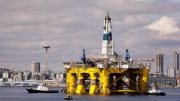 President Obama’s Clean Power Plan has rightly been hailed as the most important action any president has taken to address the climate crisis. The new rule requires the nation’s power plants to cut their carbon dioxide emissions to 32 percent below 2005 levels by 2030.
President Obama’s Clean Power Plan has rightly been hailed as the most important action any president has taken to address the climate crisis. The new rule requires the nation’s power plants to cut their carbon dioxide emissions to 32 percent below 2005 levels by 2030.
[…]
There’s no getting around the fact that a large number of coal-fired power plants are likely to close their doors in the near future. The Clean Power Plan will be at least partially responsible for many of these closings. A recent study by the United States Energy Information Administration estimated that almost 90 gigawatts of coal-fired electric generating capacity (close to 10 percent of the nation’s total) will be retired by 2020, and that just over half of that loss will be caused by the new regulation.
But the truth is that most of the coal plants at risk should have been shuttered years ago. Traditionally, the economically useful life of a coal-fired plant was thought to be about 30 years. As of 2014, coal-fired plants in the United States had been operating for an average of 42 years, and many plants had been in service far longer. Some date all the way back to the 1950s, meaning they have already been running for twice their expected life span.
Unsurprisingly, these clunkers tend to pollute at a far higher rate than more modern plants. Since 1990, a vast majority of the new electric generation capacity in the United States has been built to burn natural gas. Gas plants emit, on average, half the carbon dioxide, a third of the nitrogen oxides and a hundredth of the sulfur oxides per megawatt hour that coal plants do. The second largest source of new capacity has been wind power, which creates no air pollution at all
[…]
Nearly 45 years ago, an almost unanimous Congress passed the Clean Air Act, which had the remarkably ambitious goal of eliminating essentially allair pollution that posed a threat to the public.
But however lofty its goals, the law contained a terrible flaw: Existing industrial facilities — most notably, electric power plants — were largely exempt from direct federal regulation. For some of the most ubiquitous pollutants, like those that form soot and smog, only newly constructed facilities would face limits on their emissions.
This “grandfathering” of old power plants didn’t seem terribly consequential at the time. Soon enough, it was thought, those plants would run out their useful lives and close down, making way for new facilities that would be subject to federal standards.
But that expectation turned out to be wrong. By instituting different regulatory regimes for new and existing plants, Congress had significantly altered the math behind decisions to retire plants.
[…]
Richard L. Revesz and Jack Lienke
Full version is available
on New York Times
August 3, 2015





Be the first to comment on "Obama’s Crucial Step on Climate Change"